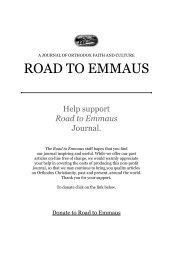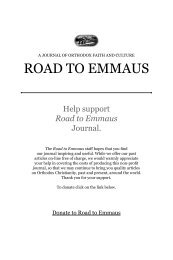RTE No 20 Interior - Road to Emmaus Journal
RTE No 20 Interior - Road to Emmaus Journal
RTE No 20 Interior - Road to Emmaus Journal
Create successful ePaper yourself
Turn your PDF publications into a flip-book with our unique Google optimized e-Paper software.
<strong>Road</strong> <strong>to</strong> <strong>Emmaus</strong> Vol. XII, <strong>No</strong>. 1 (#44)optina’s second springdation of monastic life, and also our practice of eating <strong>to</strong>gether at trapeza. Atmeals we read the lives of the saints—most often the teachings of the Optinaelders, so we feed both body and soul with Optina food.Do you know how Optina’s namestnik set the brothers free from beingattached <strong>to</strong> things? At first, he used <strong>to</strong> move them from one cell <strong>to</strong> anotherevery year, and some of the brothers would ask for a truck <strong>to</strong> move theirthings. Then he began moving them twice a year, and now they asked onlyfor a car. When he began <strong>to</strong> move them even more frequently, the brothersbegan asking the monk whose cell they were moving in<strong>to</strong> <strong>to</strong> describe it, exchanginginformation about what was there, down <strong>to</strong> the books. Most endedup with only one bag, moving from room <strong>to</strong> room.Reclaiming the MonasteryAs I said earlier, the authorities didn’t give the monastery back all at oncebecause there were forty families living there, as well as the agriculturalteachers and students who were still going <strong>to</strong> school. There were also familiesin the skete. In order <strong>to</strong> take possession of the monastery, we had <strong>to</strong> findapartments or homes in the area of Kozelsk at our own expense for all ofthese people <strong>to</strong> live in, and they had <strong>to</strong> agree <strong>to</strong> move.There are many incredible s<strong>to</strong>ries from these early years, but I rememberone in particular. In half of St. Amvrosy’s old cell in the St. John the ForerunnerSkete, there lived a man named Constantine Abramov. Our first taskwas <strong>to</strong> get these two rooms free. We had very little money and the monasterygave the namestnik the task of bargaining with him. An entire house for afamily could be bought for 5000 rubles at that time, and Constantine andhis wife lived in only two of the rooms of St. Amvrosy’s cell, but he wanted10,000 rubles <strong>to</strong> move out—the cost of two houses. In these long talks aboutthe sale, Constantine would bring up many different objections, and evenafter they finally agreed on the price, he decided that the notarized contractwas not made up properly, so he refused <strong>to</strong> sign until the wording was altered.Finally, he stipulated that we had <strong>to</strong> give the payment in one, three,and five ruble notes. Everything was complicated.Finally one evening, I invited him <strong>to</strong> the office. I was the econom of themonastery, and gave him the sum in one, three, and five ruble notes, just ashe’d asked. In order <strong>to</strong> make up the 10,000 rubles, it was a huge bag, and Iasked him <strong>to</strong> count it. When he saw the immense pile of banknotes he said,Opposite: Staretz Ambrose of Optina, late 19th century.1011










